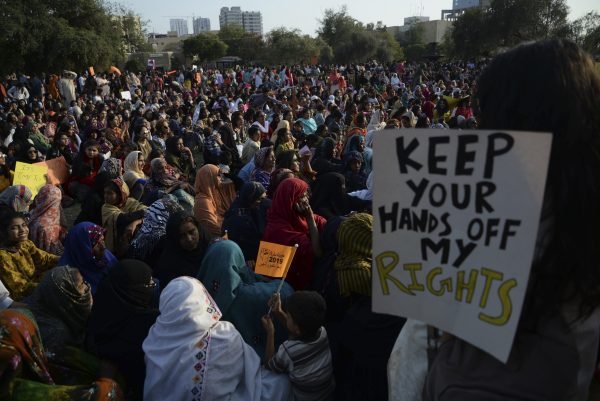Feminist scholar Sara Ahmed reminds us that hate circulates through signs, bodies, and repetition. In a country like Pakistan, this circulation of hate is evidently visible in the targeted harassment of feminist activists. Such hate manifests as digital misogyny, public intimidation, and physical threats, which function to police and silent feminist voices. This hate is not random but a part of a larger affective economy designed to sustain patriarchal power by branding feminists as foreign threat.
But this backlash is not simply a repression. It is a productive force that actively shapes feminist activism. I argue that persistent harassment, threats, and censorship have collectively reshaped the feminist involvement in Pakistan. It helped activists to evolve, adapt, and rethink their strategies with a deeper commitment to intersectionality. However, at the same time, translating these shifts into lasting structural change is a formidable challenge in a traditional, political, and legal environment that remains hostile to feminist demands.
The cost of visibility
One of the first lessons I learned as a feminist in Pakistan is that visibility is a gamble. The more visible we are, the more vulnerable we become.
This visibility does not exist in a vacuum. But it threatens power and challenges the system. When feminists claim more space, those systems respond aggressively. In Pakistan, this response often takes the form of public intimidation and targeted harassment. These acts function as a form of gendered social control by sending warnings to others about the cost of speaking out.
Threats of acid attacks, rape, and death are routine for feminist activists, especially those involved in events like the Aurat March. But this hostility is not limited to prominent names. The threat of doxxing, sexualized insults, and reputational harm deters many younger or less visible feminists even with minimal public engagement. With lack of protection, this visibility sometimes becomes a double edged sword, pushing many to retreat from public platforms or operate under pseudonyms.
Online platforms such as Twitter (now X) and Facebook have become key sites of patriarchal backlash. According to a 2023 Digital Rights Foundation report, over 55% of women activists in Pakistan have faced direct threats tied to their feminist work. Tactics include doctored images, mass reporting campaigns, misogynistic slurs, and false accusations aimed at legal or religious persecution.
Activists are branded as “western agents” to delegitimize feminist claims and provide cover for institutional repression without political consequence.
However, digital misogyny is not only confined to screen but it reinforces offline intimidation by normalizing hostility toward women in public spaces. This regression has even reached universities.
Gender studies departments at several Pakistani universities have faced censorship or outright bans. A 2020 petition in Lahore demanded closure of gender studies programs, accusing them of promoting “immoral” values and undermining cultural norms. Feminist thought, in this framing, becomes not a critique of power but a threat to be eradicated.
But we don’t disappear
Yet despite intensified repression, feminists in Pakistan refuse to disappear. Instead, they show remarkable resilience. The backlash has sharpened their awareness of vulnerabilities and pushed movements toward more strategic, intersectional, and decentralized organizing. Their rage has become not just a response but a generative force.
Activists are adopting robust digital security measures to protect themselves and their communities. Encrypted messaging apps, anonymous social media profiles, women only Facebook groups, and alternative platforms help avoid surveillance and trolling. Organizations like the Digital Rights Foundation provide training to hundreds of women in digital hygiene by recognizing cybersecurity as a feminist practice.
Moreover, feminist movements are also redefining the “who” of feminism. There is now explicit rejection of elite and neoliberal feminism in favor of grassroots and intersectional resistance. The people who are often marginalized by both the state and mainstream feminism have gained recognition. This shift challenges simplistic binaries of gender and class by showing how oppression is complex and layered.
But this approach is not just symbolic, it is transformative. Feminist collectives are also building cross-class alliances with brick kiln workers, sanitation workers, fisherwomen, and transgender-led clinics to address issues like land rights, food insecurity, wage theft, and healthcare access. They are also campaigning for structural changes to end gender-based violence, secure economic justice, and increase political representation.
Moreover, new solidarities are also emerging from unexpected quarters. Progressive men, especially younger urbanites, are entering feminist spaces with openness. They participate in consent education and challenge toxic masculinity publicly. Studies even document the rise of “feminist fathers” who advocate gender-equitable parenting and signal shifting perceptions of masculinity. But this turn toward power redistribution and structural inclusion is not just a political choice rather it is a response to the backlash.
The more feminists are attacked, the more they rethink who belongs in the movement.
They have learned that survival depends on building broader alliances and including the voices of marginalized communities. This inclusion is a form of resistance. This makes the movement harder to ignore, harder to divide, and harder to control by elites or softened by NGOs.
Therefore, while the backlash initially aimed to silence feminists, it has instead forced them to become more united, more grounded, and more focused on real but structural change.
But despite this resilience, the costs are real: emotional fatigue, paranoia, and constant fear of violence take a toll. But if backlash is the storm then organizing is what helps people survive and even gives them a chance to imagine a different future.
However, this paradox of feminist evolution raises an urgent question: How can feminist movements sustain resilience and collective strength without succumbing to burnout under relentless backlash? Even though Pakistani feminists show great courage, lasting resistance needs more than admiration. It requires legal protections, institutional support, and international solidarity to prevent isolation and exhaustion.
Works Cited
- Firdaus, Amira, et al. “The ‘New Father’: Male Allies in Digital Feminism and the Reshaping of Patriarchal Behavior.” Masculinities & Social Change, hipatiapress.com/hpjournals/index.php/mcs/article/view/12006. Accessed 16 July 2025.
- Aslam, Rabbia. “From the Courts, to the Streets, to the University: Fighting to Save Gender Studies in Pakistan, 2018–2023.” WSQ: Women’s Studies Quarterly, The Feminist Press, 14 Apr. 2024, muse.jhu.edu/article/924318.
- Khan, Ayesha, and Nida Kirmani. “Moving beyond the Binary: Gender-Based Activism in Pakistan.” Feminist Dissent, www.researchgate.net/publication/329236574_Moving_Beyond_the_Binary_Gender-based_Activism_in_Pakistan. Accessed 16 July 2025.
- Younas, Fouzia, et al. Patriarchy and Social Media: Women Only Facebook Groups as Safe Spaces for Support Seeking in Pakistan, Conference: ICTD2020: Information and Communication Technologies and Development, www.researchgate.net/publication/342249684_Patriarchy_and_Social_Media_Women_Only_Facebook_Groups_as_Safe_Spaces_for_Support_Seeking_in_Pakistan. Accessed 16 July 2025.
- Ahmed, Sara. The Cultural Politics of Emotion, Routledge, 2015, pratiquesdhospitalite.com/wp-content/uploads/2019/03/245435211-sara-ahmed-the-cultural-politics-of-emotion.pdf.

Noor ul Sabah
Noor ul Sabah is a feminist researcher focused on intersectional approaches to gender, technology, and governance. Her work explores how power and identity shape experiences of violence, migration, and citizenship.



